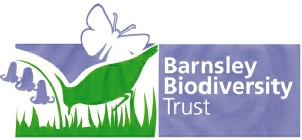



Blanket bog is an important priority wetland habitat amounting to 2164 ha on the Barnsley upland moors in the Dark Peak.
Local Priority Habitats summary
- with links below:
Running water, rivers and streams*. The local priority habitat includes all rivers and streams capable of supporting biodiversity and in particular river sections or streams in Barnsley with priority species present.
National priority river habitat in Barnsley includes headwaters to the Don and Little Don, shingle river sections of the Don and Cawthorne Dyke, and the Dearne because of the number of priority species it supports. As records are collected and water quality improves, more water courses may qualify as national priority habitat.
Reedbed*. Some priority species like bittern depend on sizeable reedbeds. Sizeable individual reedbeds or groups of reedbeds - or reedbeds that are capable of being extended - are locally important for this reason. There are at least 9ha of reedbed in the Dearne valley where bittern have begun to breed.
Lowland fen. This priority habitat is particularly scarce in Barnsley and remnants amounting to 8 ha may be found in the Dearne valley
Upland flushes, fens and swamps. This priority habitat amounts to 31 ha found on the moors and upland fringes in the west of Barnsley.
Mixed deciduous woodland. The main woodland priority habitat in Barnsley is mixed oak-birch woodland and mixed ash woodland. These fall within the national priority habitat: lowland mixed deciduous woodland of which there is 2259 ha in Barnsley.
Upland oakwood priority habitat is the woodland priority habitat in the Dark Peak area where there are only remnants in Barnsley. The character of this priority habitat should be born in mind for any planting of trees on Barnsley moors and cloughs.
Wet woodland. Willow carr is a notable form in Barnsley of the wet woodland priority habitat, the natural cover for wet soils. Other forms of wet woodland have alder and ash as dominant trees.
Parkland including veteran trees. Individual or groups of trees within grazed grassland are a priority habitat called wood pasture. In Barnsley, as elsewhere, this habitat, amounting to 610 ha, is found in historic parkland. Veteran trees are important in their own right and included in this Priority Habitat whether in parkland or elsewhere.
Traditional orchards, at least 6 ha in area, are found scattered across Barnsley. Some are longstanding and some more recently planted. [To follow]
Upland heathland covers extensive areas (296 ha) of the slopes of moors in the west of Barnsley above enclosed pastures and the 300 metre contour.
Lowland heathland is rather scarce (7 ha) and fragmented in Barnsley, found on the edges of slopes of sandstone hills, on former commons, and on former pit-stacks.
Lowland dry acid grassland (184 ha) is found in Barnsley as grazing pasture, in some parklands, and on slopes and other areas where there are nutrient poor soils. Field corners, verges and banks sometimes retain this habitat.
Neutral grassland or lowland meadow (64 ha) is found on richer shale and alluvial soils in lowland pastures and meadows in the Barnsley area. This species-rich grassland may be found in recreational sites, churchyards, roadside verges etc.
Floodplain grazing marsh (66 ha) is wet neutral grassland found in some river floodplains in Barnsley. The combination of grassland and wetland margins or ditches promotes biodiversity.
Purple moor grass and rush pasture. Pockets are found across the broad swathe of land in poorly drained, acidic soils in Barnsley between Ingbirchworth and Langsett.
All unimproved and semi-improved grassland is important for biodiversity in Barnsley.
Amenity grasslands, although not a priority habitat in the usual sense, can also be managed to promote biodiversity and is included in this list for that reason.
Hedgerows. The UK BAP priority habitat (2007), includes all hedgerows with 80% or more of at least one native woody species of tree or shrub, with the best being ancient &/or ‘species rich' that is with at least four different native tree or shrub species.
Arable field margins*. This priority habitat consists of field margins designed to benefit key farmland species in arable areas. In-field measures like skylark plots and beetle banks are included in the Local Priority Habitat.
Barnsley’s mining, railways, and other industrial past has left a legacy of previously developed land. Many sites have been reclaimed and converted into other habitats.
Open Mosaic on previously developed land* is a national priority habitat found in Barnsley where soils have been modified and one or more early successional communities have become established in a mosaic with bare substrate.
Other specialised habitats may be found where there is industrial spoil or limestone ballast affecting the soil: the types of vegetation found may be very different to those found elsewhere in Barnsley. These are included in this Local Priority Habitat.
Built-up areas and amenity land totals 7336 ha -more than the total of all the semi-natural habitats in Barnsley put together.
The built environment, grounds, gardens and amenity land can provide a very significant resource for many common and vulnerable species. Their value, with that of the wider urban area, should not be ignored. For this reason a section has been added to the local biodiversity plan with descriptions of how to promote biodiversity in these settings.
- to follow -
Standing water and ponds *. The local priority habitat includes all standing water that is capable of supporting biodiversity and especially populations of key species.
Standing water in Barnsley, at least 404 ha in area, ranges from acidic moorland reservoirs such as Winscar, and lowland reservoirs like Worsbrough, to small lakes and ponds, remnants of canals, and an array of drainage ditches. There are also subsidence flashes and areas of open water within flooded wetlands.
Continued below